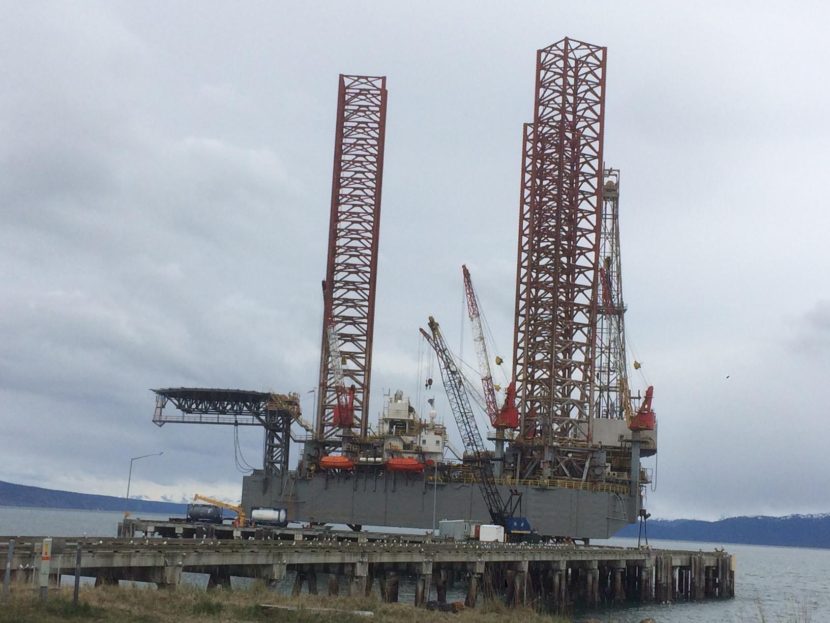
The Randolph Yost, a jackup rig contracted by Furie Operating Alaska, is currently docked in the Port of Homer and the city is making $1,000 per day in dockage fees. The port provided similar services to another rig in 2012, but in the process a set of rules the state created to protect Kachemak Bay were broken.
The state legislature passed a law back in 1974 to designate Kachemak Bay a critical habitat area. Legislators wanted to protect the fish and wildlife in the bay from human interference. But, that decision actually posed a problem for the City of Homer.
The Department of Fish and Game oversees a management plan for the Kachemak Bay Critical Habitat Area. The plan outlines what is and isn’t allowed. The Homer Port and Harbor were inside of the critical habitat area and, according to the plan written in 1993, no drill rigs were allowed to be stored inside the port. In addition, vessels or structures moored in the port or harbor for over 14 days were required to get a special use permit from Fish and Game.
Homer Port and Harbor Director Bryan Hawkins said the plan wasn’t compatible with port and harbor operations.
“The idea that what we do here is moor vessels — and technically we were in violation of that just doing our normal operations — would tell you that we need to address that,” said Hawkins.
Hawkins said the conflict was made very clear when the Endeavour, Spirit of Independence jackup rig was brought into the port by Buccaneer Energy in 2012.
“We realized when the rig came here … they had to put the legs down because it was a safety issue. They would’ve damaged the rig or damaged our dock,” said Hawkins.
Jackup rigs come equipped with legs that can stand the platform up on the ocean floor when it is drilling. When the legs aren’t in use they stretch up into the air from the rig’s surface like massive towers. Hawkins said, under U.S. Coast Guard rules, a drill rig is considered a vessel when its legs are up. When the legs are down, the rig is considered a drilling unit again.
According to Hawkins, when the Endeavour came into the port, it was supposed to just stay for a few days. But things came up and the Endeavour ended up staying for months. One day there was a forecast of gale force winds and a choice had to be made.
“There’s just no way that they can moor like a normal vessel to the facility, because there’s just too much sail area with those big legs sticking up in the air,” said Hawkins.
The Endeavour’s crew decided the safest option for humans and wildlife alike was to stabilize the rig by lowering its legs onto the sea floor. But that put Buccaneer in violation of the management plan.
Hawkins said an environmental impact study showed there was no damage to habitat, but the city decided it needed the state to remove the port and harbor from the critical habitat area. Sen. Peter Micciche of Soldotna sponsored a bill to do that in 2014 and the bill passed. Hawkins said that’s why it’s legal for the Randolph Yost jackup rig to stand on its legs in the port.
Bob Shavelson, executive director of Cook Inletkeeper thinks the bill went too far. He’d rather have just seen the management plan for the critical habitat area revised.
“I think you have to recognize certain provisions for industrial activities around our industrial hub there and build those in. But, also build in some protections. So there’s some sideboards there. It shouldn’t just be nilly willy management there,” said Shavelson.
Shavelson acknowledged the economic impact drill rigs spark when they come into the port can be beneficial, but he said it’s also important to pay attention to the impact rigs can have on marine life.
“We’re seeing these radical, radical changes in Kachemak Bay in a very short time and we know scientifically that it’s our combustion of fossil fuels that’s causing these changes. And yet, we’re facilitating the continuation of these activities,” said Shavelson.
Hawkins said even though the port and harbor aren’t included in the critical habitat area anymore, everyone who uses them still has to follow regulations created to protect the environment. He also doesn’t think adding more restrictions to the management plan will help if more resources aren’t dedicated to enforce those rules.
Shavelson said habitat management plans are being revised around the state and he believes Kachemak Bay’s will come up for discussion in the next two years.
